(Written by William)
From the selection of LEGO summer sets, I was happy to get a copy of the #31151 LEGO Creator 3-in-1 T. Rex. I recently built the #31154 LEGO Forest Animals: Red Fox set and was astounded by its high-level building experience (see: Brick Breakdown: LEGO Creator Red Fox). Considering the T. Rex seemed about the same size, I crossed my fingers and hoped I’d have a similar experience.
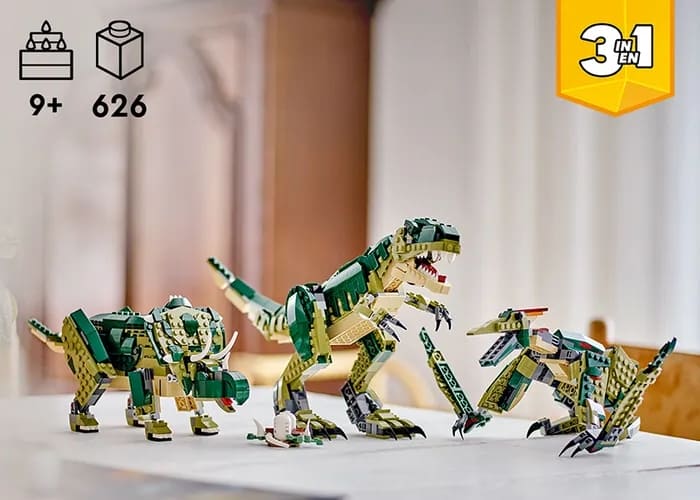
Good news, I did! LEGO designers did a marvelous job hiding all the points of articulation while still sculpting a fierce beast from prehistory. And the small touches like the transparent-green bars inserted to help make the eyes of the T. Rex really show how much the designers paid attention to details.
Unlike the Red Fox, I think this model will be a little handier to have. Given that the T-Rex is such a large creature, it also seems to be properly scaled to minifigures, whereas the Red Fox is not. This makes the T. Rex both a play and display model. And the price of $59.99 is fairly affordable.
Convincing a kid to like this set is probably not too hard since it looks awesome. It is the adults that might need the extra push. So, let’s take a look at some of this model’s finer building points that might attract more mature builders.
LEGO T. REX – FULCRUM DISTANCE
One of the features I really like about this set is how the T. Rex balances on two legs. Normally, LEGO designers will make this work by having the legs heavier than other parts of the model. They might also make the feet a bit larger than one might expect. But what can you do when the top half of the model has to stick out pretty far beyond the legs? Well, if you aren’t hiding an extra support, like a translucent-clear third leg, then you are playing with weight.
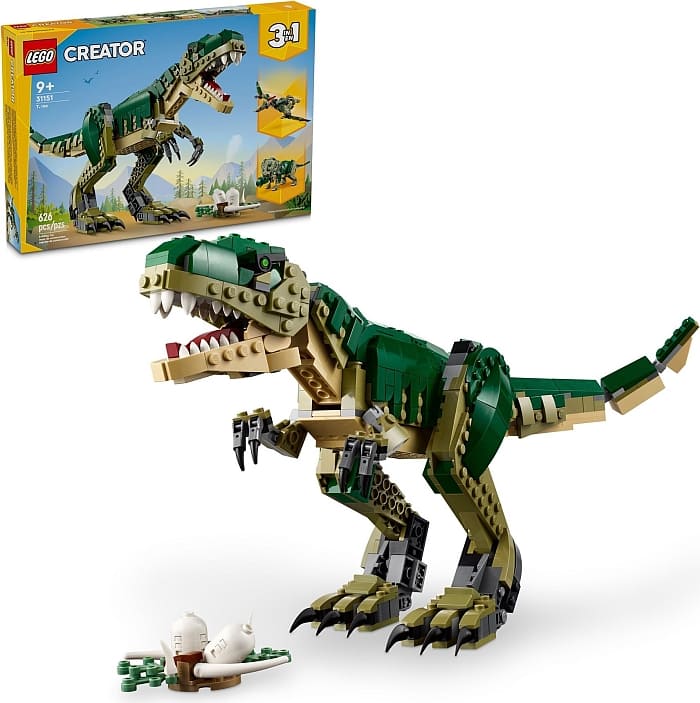
I was actually surprised by how solidly built this dino is. LEGO designers did some serious sculpting on this beast which requires packing in parts tight. This density can be a real issue. Notice how thick the head of the T. Rex is versus how thin its tail is. To balance these weights out, you have to consider it like a scale balanced on a fulcrum.
In the case of the T. Rex, the fulcrum is where the legs attach to the body. Now, if your goal is to exert more weight to counterbalance something with more mass, like the dino’s head, then you need to stretch out farther from the fulcrum.
This was a simple science experiment I learned all the way back in middle school. The farther away you get from the center of where you are balanced, the more leverage you have. Think of a hammer and the claws on one end to pry up nails. You don’t grab the handle near the hammer head to pry out a stubborn nail, instead, you grab farther back on the handle to make the job easier.
A similar principle is being used here. The dino’s tail gets thinner the farther it goes from the body. However, it extends so much farther out that it can offset the front of the T. Rex. Used in this way, the dino can stretch out and look like it can put on some serious speed.
Builders can sometimes forget about how weight might shift around. Put a large hinge on a big model and you might find it tipping over really fast. Sometimes it’s because they forgot to put a support under the model in the right space, but it might also be because they put some distance between that section and the nearest leg acting as a fulcrum.
LEGO T. REX – BENDING PLATES
LEGO fans have been doing this sort of building for decades. Every gap in a model is technically a spot where the creation can flex. Typically, this is something you can do with straight plates and bricks over larger areas. However, LEGO has been adding more elements with rounded ends. This has given us the ability to position parts in more fluid and natural angles. Chances are, you’ve played with this sort of building technique in quite a few of your own sets.
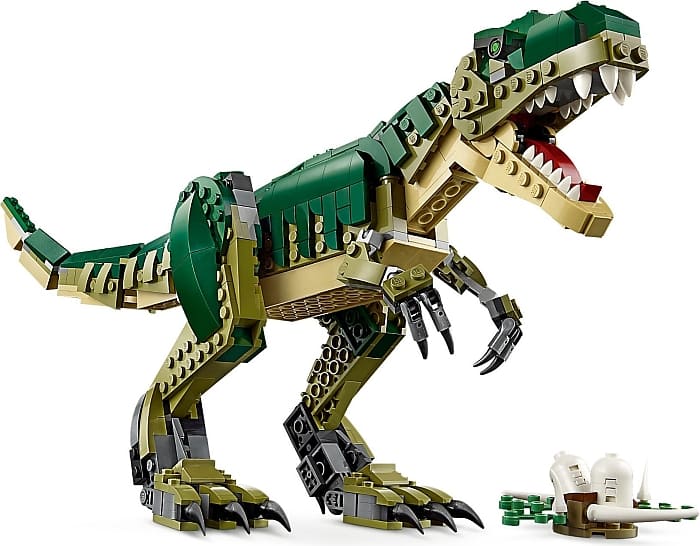
LEGO designers often use this technique when building claws. They will use a modified 1×1 rounded plate with a bar on the end and turn it to add a claw or finger on a mech. However, I was surprised to see LEGO designers use this technique in something just a tad bit larger, and they even mixed it with some straight elements.
On each of the large feet of the T. Rex, there are three distinct toes. Each toe has a clear separation from one another with the outer-most angled out. This angle is created by combining the rounded plates in the feet but still restricted by the flat elements in the foot to create a controlled bend. The toes do stick out a bit so LEGO designers needed to secure them with some interlocking. The top and bottom plates are straight, but they are next to 2×2 round plates built into the center of their layers. This gives them the ability to get bent.
Then the interior of the toes is made up of a stack of three 1×2 rounded plates. The ends of these also don’t get in the way of the bending. I think it is also interesting that the element the actual claw is attached to also has a rounded end. That means, if you want the toes to bend out, but you want the three claws to be perfectly perpendicular to each other, you have that possibility all thanks to bending.
LEGO T. REX – FINAL THOUGHTS
LEGO is getting better and better at hiding joints in brick-built creatures, especially when it comes to the internal body elements giving each model a more natural and dynamic look. Additionally, they pay attention to coloration which makes such sets great for display.
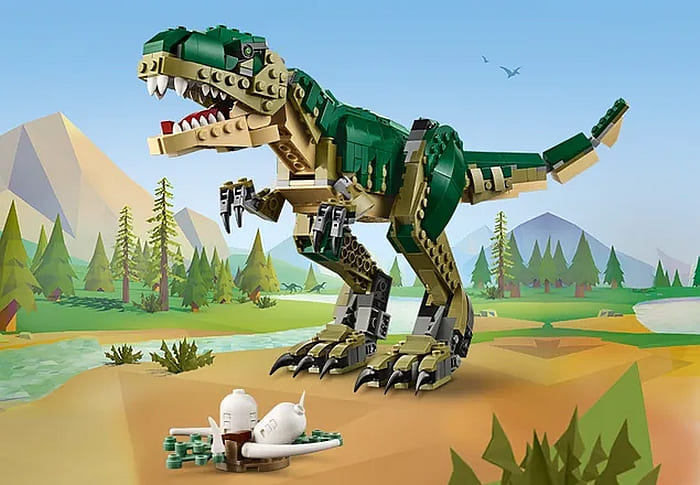
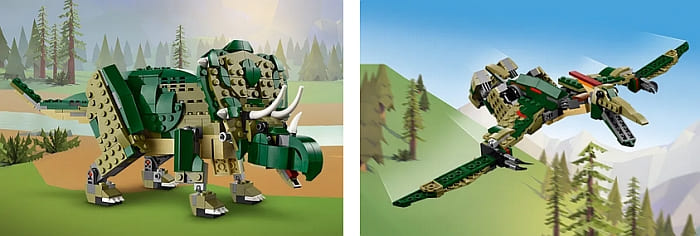
For the relatively low price, you get a highly detailed model with a build experience you might expect from an adult-marketed set. At the time of writing, the price was not yet known for this set. And you even get two alternate builds!
With that said, LEGO did mark the set as for ages nine and up. This means it also has some pretty good durability and is a decent playset. I think another aspect that makes it great for play is that it looks like it scales very well to a minifigure. Many times, dino sets feature a good-looking dino, but the scale feels somehow off when you place them next to minifigs. Granted you don’t get a minifigure with this model, but you can add your own and come up with your own stories and adventures. In the video below, I talk a bit more about the set.
In the past, I used to ignore all LEGO Creator 3-in-1 sets featuring animals. They were too bricky and unnatural. That’s no longer the case. I’ve been extremely impressed with both the building experience and the finished product with all the animals I’ve built as of late.
Those who buy a lot of LEGO might find it easy to fit this set into their shopping trip, especially if they are trying to reach a price threshold to get a Gift-With-Purchase freebie. However, even if you are more budget-conscious, this set is probably at a price where you feel you didn’t overpay. And with two other alternate models to choose from, this set really delivers on value. If you would like to check it out, it’s available at the LEGO Creator section of the Online LEGO Shop.
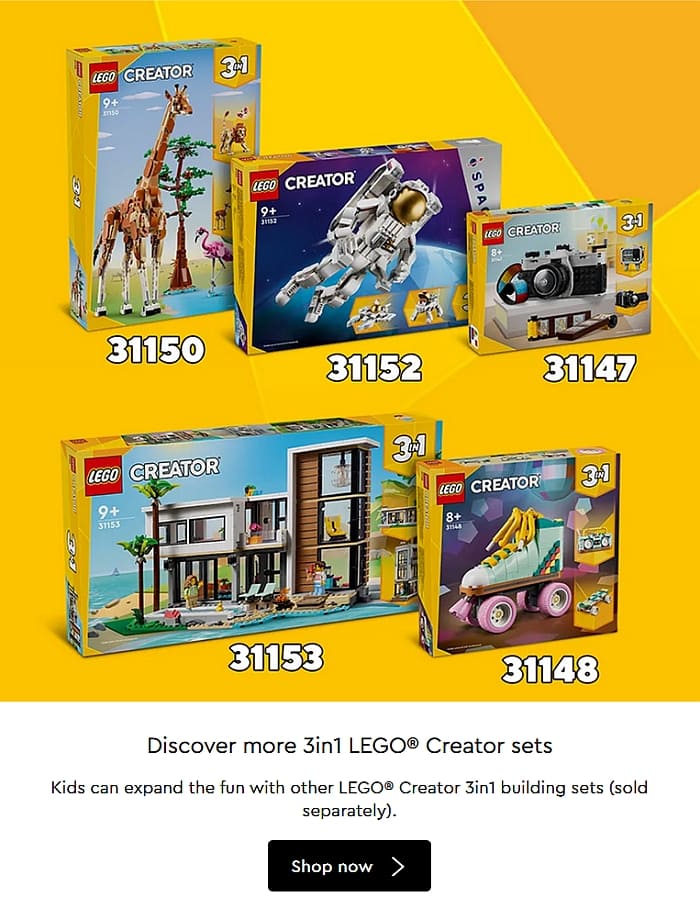
What do you think? Do you like LEGO Creator sets featuring brick-built animals? And how do you like the T. Rex? And what do you think of the building techniques we discussed here? Are there any other interesting techniques you noticed in the set? Feel free to share and discuss in the comment section below!
And you might also like to check out the following related posts:












I like all three builds in this one. One thing I would have liked you to address is how different elements are used differently in the three models. Especially unique elements.
I had 2q similar set from a few years ago. I always loved dinos. I like these better than the molded ones in the Jurassic sets
I like the olive color they added to this. It gives a more subtle color variation than on the earlier models. The alternate builds are good to. I just wish it was a little cheaper.